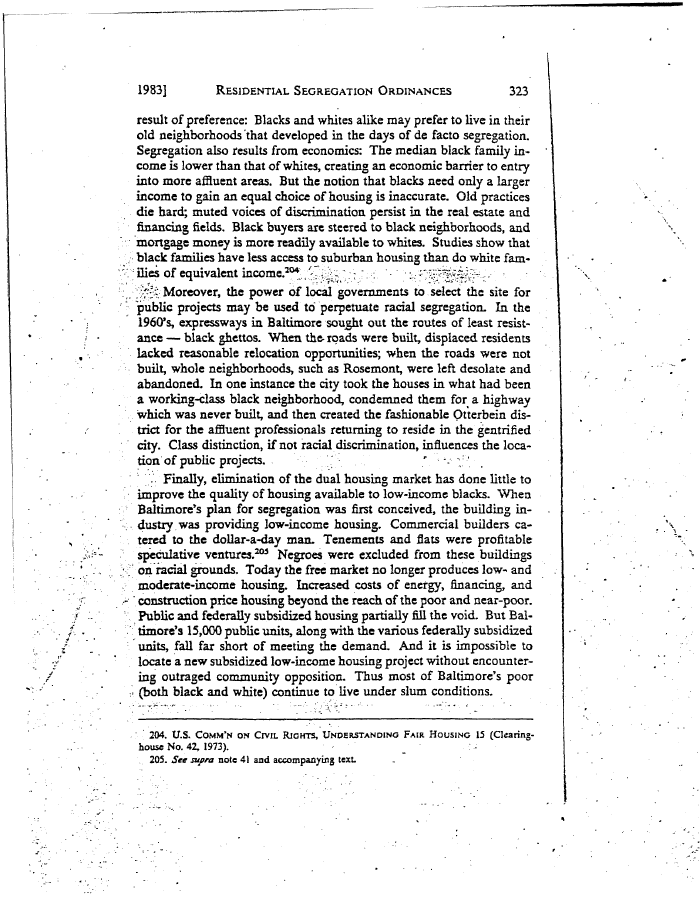 |
||||
|
Garrett Power, Apartheid Baltimore Style: The Residential Segregation Ordinances of 1910-1913, Maryland Law Review, 42 (1983) , Image No: 36 Enlarge and print image (74K) << PREVIOUS NEXT >> |
 |
||||
|
Garrett Power, Apartheid Baltimore Style: The Residential Segregation Ordinances of 1910-1913, Maryland Law Review, 42 (1983) , Image No: 36 Enlarge and print image (74K) << PREVIOUS NEXT >> |
| 1983] RESIDENTIAL SEGREGATION ORDINANCES 323 result of preference: Blacks and whites alike may prefer to live in their old neighborhoods that developed in the days of de facto segregation. Segregation also results from economics: The median black family in- come is lower than that of whites, creating an economic barrier to entry into more affluent areas. But the notion that blacks need only a larger income to gain an equal choice of housing is inaccurate. Old practices die hard; muted voices of discrimination persist in the real estate and financing fields. Black buyers are steered to black neighborhoods, and mortgage money is more readily available to whites. Studies show that black families have less access to suburban housing than do white fam- ilies of equivalent income.204 : Moreover, the power of local governments to select the site for public projects may be used to perpetuate racial segregation. In the 1960's, expressways in Baltimore sought out the routes of least resist- ance — black ghettos. When the- roads were built, displaced residents lacked reasonable relocation opportunities; when the roads were not built, whole neighborhoods, such as Rosemont, were left desolate and abandoned. In one instance the city took the houses in what had been a working-class black neighborhood, condemned them for a highway which was never built, and then created the fashionable Otterbein dis- trict for the affluent professionals returning to reside in the gentrified city. Class distinction, if not racial discrimination, influences the loca- tion of public projects. Finally, elimination of the dual housing market has done little to improve the quality of housing available to low-income blacks. When Baltimore's plan for segregation was first conceived, the building in- dustry was providing low-income housing. Commercial builders ca- tered to the dollar-a-day man. Tenements and flats were profitable speculative ventures.203 Negroes were excluded from these buildings on racial grounds. Today the free market no longer produces low- and moderate-income housing. Increased costs of energy, financing, and construction price housing beyond the reach of the poor and near-poor. Public and federally subsidized housing partially fill the void. But Bal- timore's 15,000 public units, along with the various federally subsidized units, fall far short of meeting the demand. And it is impossible to locate a new subsidized low-income housing project without encounter- ing outraged community opposition. Thus most of Baltimore's poor (both black and white) continue to live under slum conditions. 204. U.S. COMM'N ON CIVIL RIGHTS, UNDERSTANDING FAIR HOUSING 15 (Clearing- house No. 42, 1973). 205. See supra note 41 and accompanying text. |